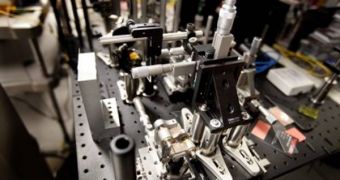Talking about the ultimate gadget! Experts at the University of California in Los Angeles (UCLA) have announced the development of the world's fastest camera, able to pick up 6.1 million frames per second. While this may seem like a thing belonging to science-fiction, the device is real and has already produced its first snapshots. According to the experts who created it, the machine's shutter has a speed of 440 trillionths of a second, an unbelievable value, considering that light itself, traveling at the speed of, well, light, only goes a fraction of a centimeter during this time interval.
Naturally, as anyone who ever worked with cameras already suspects, such brief exposure times are not enough to leave a serious “mark” on the film. Until now, that has been one of the main problems associated with high-speed cameras, namely the fact that all pictures have come out underexposed. But, with the modern device, the shutter speed is several hundred times slower than the best existing slow-motion camera, which means that special electronics had to be devised to work around this problem.
The ingenious solution that the UCLA team, led by optoelectronic specialist Keisuke Goda, found was to illuminate the target object with a beam of lasers. For each individual pixel in the camera's sensor, the lasers generate a different wavelength of infrared light. Still, only a few photons made it to the pixels, on account of the extremely high shutter speed. So, the research team has created a system that artificially amplifies the wavelengths detected by each of the pixels, and boosts their sensitivity until the image becomes visible to the human eye.
“We have invented a new type of imaging technology that overcomes the fundamental limitation between sensitivity and speed. It’s the world’s fastest camera,” Goda said, quoted by WIRED. “The camera has a built-in optical image amplifier that overcomes the tradeoff between sensitivity and speed. It could be especially useful for microscopy. On the meta-microscale, even slow-moving objects require a high temporary resolution, because your field of view is so small.”
The new serial time-encoded amplified microscopy (STEAM) camera would undoubtedly have a number of significant applications in the field of microscopy, and especially in medicine and in the study of cellular and molecular interactions. These processes occur at very high speeds, and identifying all the factors involved in them could lead to the creation of new drugs for a host of medical conditions.

 14 DAY TRIAL //
14 DAY TRIAL //